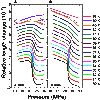Breakdown of Hooke's law of elasticity at the Mott critical endpoint in an organic conductor
- PMID: 27957540
- PMCID: PMC5142797
- DOI: 10.1126/sciadv.1601646
Breakdown of Hooke's law of elasticity at the Mott critical endpoint in an organic conductor
Abstract
The Mott metal-insulator transition, a paradigm of strong electron-electron correlations, has been considered as a source of intriguing phenomena. Despite its importance for a wide range of materials, fundamental aspects of the transition, such as its universal properties, are still under debate. We report detailed measurements of relative length changes ΔL/L as a function of continuously controlled helium-gas pressure P for the organic conductor κ-(BEDT-TTF)2Cu[N(CN)2]Cl across the pressure-induced Mott transition. We observe strongly nonlinear variations of ΔL/L with pressure around the Mott critical endpoint, highlighting a breakdown of Hooke's law of elasticity. We assign these nonlinear strain-stress relations to an intimate, nonperturbative coupling of the critical electronic system to the lattice degrees of freedom. Our results are fully consistent with mean-field criticality, predicted for electrons in a compressible lattice with finite shear moduli. We argue that the Mott transition for all systems that are amenable to pressure tuning shows the universal properties of an isostructural solid-solid transition.
Keywords: Mott metal-insulator-transiton; Strongly correlated electron systems; coupling of electrons to lattice degrees of freedom; critical phenomena; effects of hydrostatic pressure; organic charge-transfer salts; thermal expansion; thermodynamic studies.
Figures




References
-
- N. F. Mott, Metal-Insulator Transition (WILEY-VCH Verlag, 1990).
-
- Imada M., Fujimori A., Tokura Y., Metal-insulator transitions. Rev. Mod. Phys. 70, 1039–1263 (1998).
-
- Kanoda K., Recent progress in NMR studies on organic conductors. Hyperfine Interact. 104, 235–249 (1997).
-
- N. Toyota, M. Lang, J. Müller, Low-Dimensional Molecular Metals (Springer-Verlag, Berlin Heidelberg, 2007).
-
- Shimizu Y., Miyagawa K., Kanoda K., Maesato M., Saito G., Spin liquid state in an organic Mott insulator with a triangular lattice. Phys. Rev. Lett. 91, 107001 (2003). - PubMed
LinkOut - more resources
Full Text Sources
Other Literature Sources

